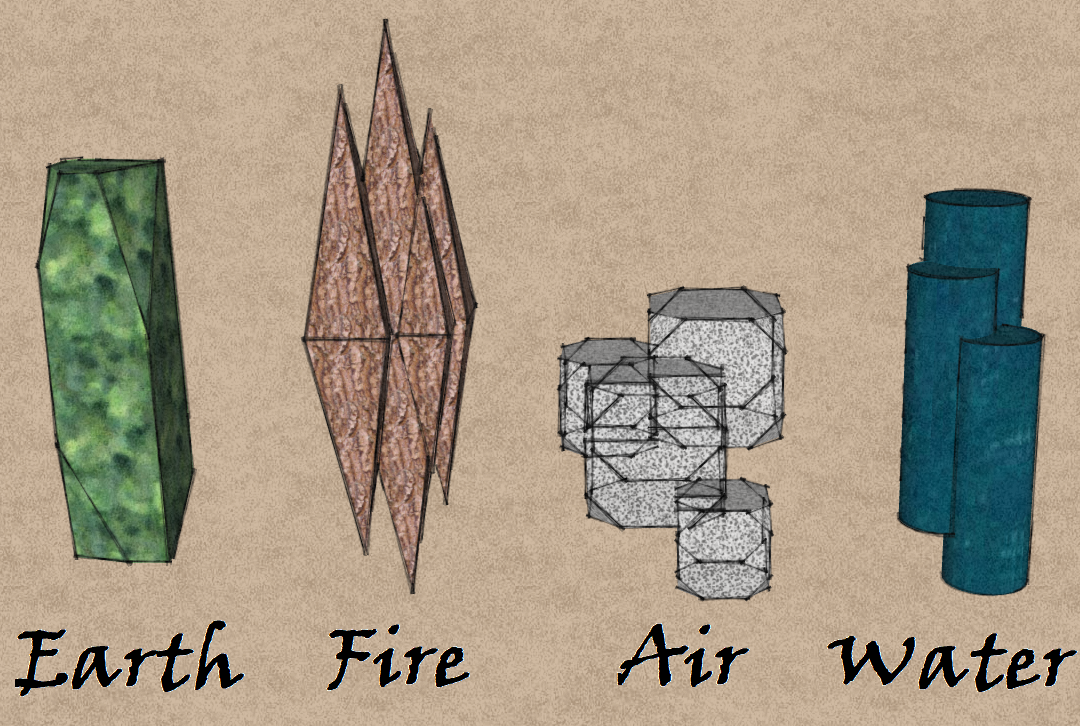Shards
Most shardfall results in a light dusting of condensed Pneuma across the landscape, which quickly evaporates and is absorbed by the local flora and fauna, providing magical sustenence. When the flow of Pneua is particularly dense, and the environmental conditions condusive to the form of Pneuma falling, it can coalesce on the ground into larger, more tangible Shards that remain until absorbed by a living creature deliberately, or collected to be used for later. This is far more common with 'pure' shardfall; Pneuma that is only tinted with the nature of one of the Natural Planes, although shards of mixed Pneuma is not unknown.
Properties
Material Characteristics
All shards look like a hard, gem-like material, slightly warm to the touch and with a faint internal glow. Their form, colour and attributes depend entirely on the nature of the Pneuma that forms them. They are never very large, less than 50 centimetres long, but larger ones are not unheard of, and whilst not brittle, can break apart with sufficient force. Talented gemsmiths can make regular shapes from naturally occurring shards, but the skill is rare.
Gravis
Shards of the Earth Element are the most commonly found, as the solid, heavier aspects of the element seem to allow it to condense much more readily. They are retangular in shape, rough to touch, and are a mottled green colour, with light and dark patches that slowly swirl around on the surface, and some have described it as smelling like wet soil. If left undisturbed, it has a tendency to burrow deeper into the ground, and gather together, resulting in larger lodes of the shards underground.Aquanis
Shards of the Water Element only tend to condense near water, be it rivers, streams, ponds, lakes or seas, or where humidity is quite high, such as in jungles. Looking like bunches of smooth cylinders, with a slippery texture, and coloured a deep, dark blue, even across its surface. They evaporate if heated too much, with the steam retaining the properties of the shard, until it disapates. Small 'fields' of water shards are found around isolated water bodies all over, until discovered and exploited.Imperis
Shards of the Air Element are the least tangible of all the shards, and appear to have very little mass, regardless of their size, and can be blown around by the wind. As a result, they tend to congregate in corners, sheltered spots, and wherever they end up. They appear as a collection of truncated cuboids of a pale white translucent colour, and feel delicate to touch, although are still hard and firm. Relatively rare, compared to water and earth shards, caches of air shards are often found in remote, hard to reach places, where the wind carried themIncedis
Shards of the Fire Element are the rarest of all the 'pure' elemental shards, as unless collected and cooled, evaporate over time. Colder Strata do keep fire shards longer, but their climates are not often condusive to the production of fire shardfall in the first place. They appear as sharp, long points, bright red, with swirls of yellows and oranges that move over the surface, and are definitely warm to touch.Others
Shards of other elemental combinations do exist, but are much rarer, and usually only occur in small areas and quantities. The most common of these other shards are Earth and Water shards, known as Mud, and Earth and Air shards, known as Dust. Both form small shards, with Mud tending to stick together, and Dust being more free form. The most unusual of all shards are those of Dark, which only form when the Null Plane intercepts the Pneuma flow during its nadir phases. They are so black as to appear to absorb all light around them, and form almost perfect spheres. Considered by many to be cursed, they are kept separately, as their ability to absorb light around them increases exponentially if kept together. The rarest of all shards found so far are those of Fire, Air and Water, or Lightning shards. Lightning shardfall has only occurred once in recorded human history, in 385, and the bright shards that formed proved very popular and useful. Even now, almost 250 years later, atrefacts powered by Lightning shards are still in use. Light Shards, made of all four Elements coming together are a hypothesised Shard, but so far have never been formed.
Type
Ore/Mineral
Remove these ads. Join the Worldbuilders Guild




Comments